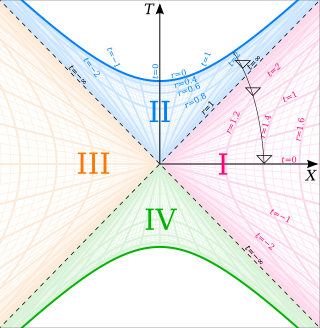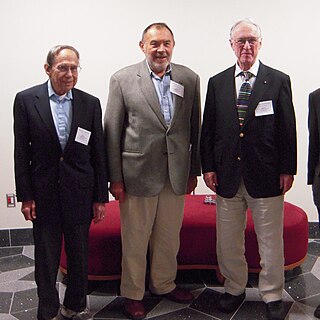
General relativity, also known as the general theory of relativity and Einstein's theory of gravity, is the geometric theory of gravitation published by Albert Einstein in 1915 and is the current description of gravitation in modern physics. General relativity generalizes special relativity and refines Newton's law of universal gravitation, providing a unified description of gravity as a geometric property of space and time or four-dimensional spacetime. In particular, the curvature of spacetime is directly related to the energy and momentum of whatever matter and radiation are present. The relation is specified by the Einstein field equations, a system of second order partial differential equations.
Hawking radiation is the theoretical thermal black-body radiation released outside a black hole's event horizon. This is counterintuitive because once ordinary electromagnetic radiation is inside the event horizon, it cannot escape. It is named after the physicist Stephen Hawking, who developed a theoretical argument for its existence in 1974. Hawking radiation is predicted to be extremely faint and is many orders of magnitude below the current best telescopes' detecting ability.
In the mathematical field of differential geometry, a metric tensor is an additional structure on a manifold M that allows defining distances and angles, just as the inner product on a Euclidean space allows defining distances and angles there. More precisely, a metric tensor at a point p of M is a bilinear form defined on the tangent space at p, and a metric field on M consists of a metric tensor at each point p of M that varies smoothly with p.
In physics, in particular in special relativity and general relativity, a four-velocity is a four-vector in four-dimensional spacetime that represents the relativistic counterpart of velocity, which is a three-dimensional vector in space.

In physics, black hole thermodynamics is the area of study that seeks to reconcile the laws of thermodynamics with the existence of black hole event horizons. As the study of the statistical mechanics of black-body radiation led to the development of the theory of quantum mechanics, the effort to understand the statistical mechanics of black holes has had a deep impact upon the understanding of quantum gravity, leading to the formulation of the holographic principle.
The Kerr metric or Kerr geometry describes the geometry of empty spacetime around a rotating uncharged axially symmetric black hole with a quasispherical event horizon. The Kerr metric is an exact solution of the Einstein field equations of general relativity; these equations are highly non-linear, which makes exact solutions very difficult to find.
The Unruh effect is a theoretical prediction in quantum field theory that an observer who is uniformly accelerating through empty space will perceive a thermal bath. This means that even in the absence of any external heat sources, an accelerating observer will detect particles and experience a temperature. In contrast, an inertial observer in the same region of spacetime would observe no temperature.

The black hole information paradox is a paradox that appears when the predictions of quantum mechanics and general relativity are combined. The theory of general relativity predicts the existence of black holes that are regions of spacetime from which nothing—not even light—can escape. In the 1970s, Stephen Hawking applied the semiclassical approach of quantum field theory in curved spacetime to such systems and found that an isolated black hole would emit a form of radiation. He also argued that the detailed form of the radiation would be independent of the initial state of the black hole, and depend only on its mass, electric charge and angular momentum.
Rindler coordinates are a coordinate system used in the context of special relativity to describe the hyperbolic acceleration of a uniformly accelerating reference frame in flat spacetime. In relativistic physics the coordinates of a hyperbolically accelerated reference frame constitute an important and useful coordinate chart representing part of flat Minkowski spacetime. In special relativity, a uniformly accelerating particle undergoes hyperbolic motion, for which a uniformly accelerating frame of reference in which it is at rest can be chosen as its proper reference frame. The phenomena in this hyperbolically accelerated frame can be compared to effects arising in a homogeneous gravitational field. For general overview of accelerations in flat spacetime, see Acceleration and Proper reference frame.
In general relativity, the pp-wave spacetimes, or pp-waves for short, are an important family of exact solutions of Einstein's field equation. The term pp stands for plane-fronted waves with parallel propagation, and was introduced in 1962 by Jürgen Ehlers and Wolfgang Kundt.
In physics, a Killing horizon is a geometrical construct used in general relativity and its generalizations to delineate spacetime boundaries without reference to the dynamic Einstein field equations. Mathematically a Killing horizon is a null hypersurface defined by the vanishing of the norm of a Killing vector field. It can also be defined as a null hypersurface generated by a Killing vector, which in turn is null at that surface.
When studying and formulating Albert Einstein's theory of general relativity, various mathematical structures and techniques are utilized. The main tools used in this geometrical theory of gravitation are tensor fields defined on a Lorentzian manifold representing spacetime. This article is a general description of the mathematics of general relativity.

In general relativity, Kruskal–Szekeres coordinates, named after Martin Kruskal and George Szekeres, are a coordinate system for the Schwarzschild geometry for a black hole. These coordinates have the advantage that they cover the entire spacetime manifold of the maximally extended Schwarzschild solution and are well-behaved everywhere outside the physical singularity. There is no coordinate singularity at the horizon.
In theoretical physics, Nordström's theory of gravitation was a predecessor of general relativity. Strictly speaking, there were actually two distinct theories proposed by the Finnish theoretical physicist Gunnar Nordström, in 1912 and 1913 respectively. The first was quickly dismissed, but the second became the first known example of a metric theory of gravitation, in which the effects of gravitation are treated entirely in terms of the geometry of a curved spacetime.
In theoretical physics, particularly fringe physics, polarizable vacuum (PV) and its associated theory refer to proposals by Harold Puthoff, Robert H. Dicke, and others to develop an analog of general relativity to describe gravity and its relationship to electromagnetism.

The Arnowitt–Deser–Misner (ADM) formalism is a Hamiltonian formulation of general relativity that plays an important role in canonical quantum gravity and numerical relativity. It was first published in 1959.
A sonic black hole, sometimes called a dumb hole or acoustic black hole, is a phenomenon in which phonons are unable to escape from a region of a fluid that is flowing more quickly than the local speed of sound. They are called sonic, or acoustic, black holes because these trapped phonons are analogous to light in astrophysical (gravitational) black holes. Physicists are interested in them because they have many properties similar to astrophysical black holes and, in particular, emit a phononic version of Hawking radiation. This Hawking radiation can be spontaneously created by quantum vacuum fluctuations, in close analogy with Hawking radiation from a real black hole. On the other hand, the Hawking radiation can be stimulated in a classical process. The boundary of a sonic black hole, at which the flow speed changes from being greater than the speed of sound to less than the speed of sound, is called the event horizon.
The following outline is provided as an overview of and topical guide to black holes:
In general relativity, the de Sitter–Schwarzschild solution describes a black hole in a causal patch of de Sitter space. Unlike a flat-space black hole, there is a largest possible de Sitter black hole, which is the Nariai spacetime. The Nariai limit has no singularities, the cosmological and black hole horizons have the same area, and they can be mapped to each other by a discrete reflection symmetry in any causal patch.
Within general relativity (GR), Einstein's relativistic gravity, the gravitational field is described by the 10-component metric tensor. However, in Newtonian gravity, which is a limit of GR, the gravitational field is described by a single component Newtonian gravitational potential. This raises the question to identify the Newtonian potential within the metric, and to identify the physical interpretation of the remaining 9 fields.










